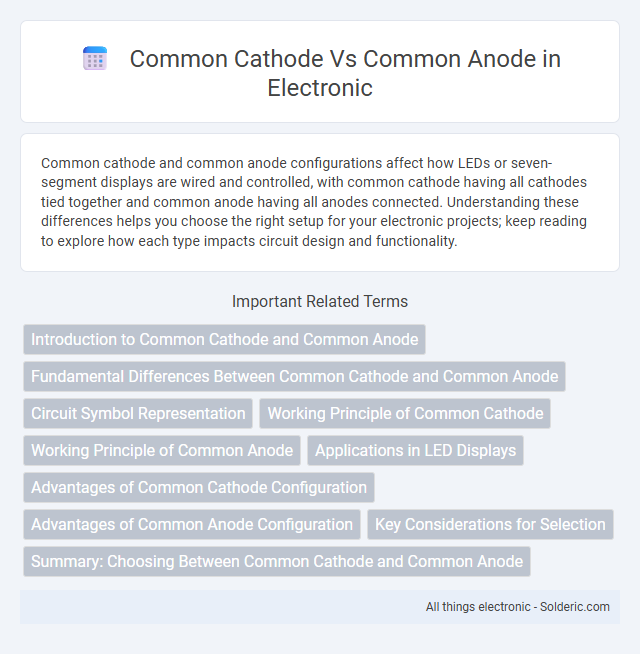Common cathode and common anode configurations affect how LEDs or seven-segment displays are wired and controlled, with common cathode having all cathodes tied together and common anode having all anodes connected. Understanding these differences helps you choose the right setup for your electronic projects; keep reading to explore how each type impacts circuit design and functionality.
Comparison Table
| Feature | Common Cathode (CC) | Common Anode (CA) |
|---|---|---|
| Definition | All cathodes connected together to ground | All anodes connected together to positive voltage |
| Connection | Common pin tied to ground (0V) | Common pin tied to Vcc (positive supply) |
| Activation | Segment lights up when input is High (logic 1) | Segment lights up when input is Low (logic 0) |
| Usage | Preferred with positive logic controllers | Preferred with negative logic controllers |
| Power Consumption | Generally lower for some applications | May vary depending on circuit design |
| Control Logic | Active High | Active Low |
| Typical Application | Microcontroller display interfaces | Legacy or specific logic-level circuits |
Introduction to Common Cathode and Common Anode
Common Cathode and Common Anode configurations are fundamental in managing LED displays and digital electronics. Common Cathode denotes an arrangement where all cathode terminals are connected to a single point, typically ground, allowing control through the anode side. Common Anode connects all anode terminals together, usually to a positive voltage, enabling control via the cathode side, which influences how you design and interface your circuits.
Fundamental Differences Between Common Cathode and Common Anode
Common Cathode and Common Anode LEDs differ primarily in their electrical connections and voltage polarity requirements; a Common Cathode configuration connects all LED cathodes to ground, requiring a positive voltage on individual anodes to light up each segment, whereas a Common Anode setup ties all LED anodes to a positive voltage, necessitating grounding each individual cathode to illuminate. This fundamental distinction influences driver circuit design, with Common Cathode displays favoring low-side switching and Common Anode displays using high-side switching for segment control. Understanding these differences is critical for selecting the appropriate configuration based on the microcontroller or driver circuitry in applications like seven-segment displays and LED matrices.
Circuit Symbol Representation
The circuit symbol for a common cathode LED display shows all the LED cathodes connected to a single common pin, typically represented as a grounded line, with individual anodes connected to separate control lines. Conversely, a common anode display's symbol depicts all the anodes tied to a single positive voltage rail, with cathodes individually controlled. Understanding these differences in symbol representation helps you accurately design and interpret LED circuit schematics for effective implementation.
Working Principle of Common Cathode
The working principle of a common cathode LED display involves connecting all the cathode terminals of the LEDs together, allowing them to share a common ground. By applying a positive voltage to individual anodes, specific segments light up to form the desired characters or patterns. Your control system must provide the appropriate signals to the anode pins, enabling selective illumination and efficient display management.
Working Principle of Common Anode
The working principle of a common anode LED display involves connecting the anode terminals of all LEDs to a positive voltage supply, while individual cathodes are connected to ground through control circuitry. This configuration allows each LED segment to be illuminated by applying a low signal to its cathode, enabling current to flow from the common anode through the LED to ground. Common anode displays are widely used in multiplexed LED projects due to their ease of controlling cathode switching with microcontrollers.
Applications in LED Displays
Common cathode and common anode configurations are essential in LED displays for controlling pixel illumination. Common cathode displays share a single ground connection for all LEDs, making them ideal for multiplexed LED matrices and segment displays where individual LEDs are turned on by applying a high voltage to the anode. You should choose common anode displays when the control circuit sources current, since all LED anodes connect to a positive voltage line, simplifying design in microcontroller-driven RGB displays and digital numeric systems.
Advantages of Common Cathode Configuration
The Common Cathode configuration offers advantages such as simpler circuit design for driving multiple LEDs using positive voltage control, enhancing compatibility with microcontrollers and integrated circuits that source current. It reduces power consumption by minimizing the need for additional switching components and provides improved reliability in multiplexed display applications due to its stable ground reference. This configuration also facilitates easier troubleshooting and maintenance in LED arrays, making it a preferred choice in digital display systems.
Advantages of Common Anode Configuration
The common anode configuration offers easier control in multiplexed LED displays by sharing a single positive voltage line, reducing wiring complexity and power consumption. It allows for simplified circuit design when using NPN transistors or N-channel MOSFETs as switches, enhancing switching efficiency. This setup also improves grounding consistency, which can lead to more stable and reliable LED operation in various electronic applications.
Key Considerations for Selection
When choosing between common cathode and common anode configurations, consider the type of driving circuitry and voltage requirements of your project. Common cathode displays connect all cathodes together and are typically driven by sourcing current, making them suitable for microcontrollers that can supply current outputs. Your selection should align with the logic level compatibility and simplify wiring complexity to ensure optimal performance and ease of integration.
Summary: Choosing Between Common Cathode and Common Anode
Choosing between common cathode and common anode configurations depends on your device's wiring and voltage requirements. Common cathode LEDs have all cathodes connected to ground, making them ideal for driving individual LEDs with positive voltages. Common anode LEDs have all anodes connected to a positive voltage source, suitable for applications needing current sinking through microcontroller pins.
Common Cathode vs Common Anode Infographic

 solderic.com
solderic.com